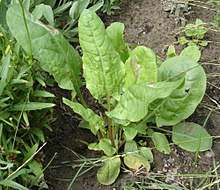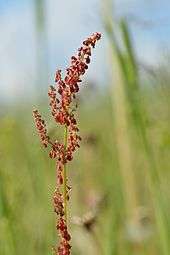Sorrel
Common sorrel or garden sorrel (Rumex acetosa), often simply called sorrel, is a perennial herb in the family Polygonaceae. Other names for sorrel include spinach dock and narrow-leaved dock. It is a common plant in grassland habitats and is cultivated as a garden herb or salad vegetable (pot herb).
| Sorrel | |
|---|---|
 | |
| Scientific classification | |
| Kingdom: | Plantae |
| Clade: | Tracheophytes |
| Clade: | Angiosperms |
| Clade: | Eudicots |
| Order: | Caryophyllales |
| Family: | Polygonaceae |
| Genus: | Rumex |
| Species: | R. acetosa |
| Binomial name | |
| Rumex acetosa | |
| Synonyms[1] | |
| |

.jpg)
Description
Sorrel is a slender herbaceous perennial plant about 60 centimetres (24 inches) high, with roots that run deep into the ground, as well as juicy stems and edible, arrow-shaped (sagittate) leaves. The leaves, when consumed raw, have a sour taste. The lower leaves are 7 to 15 centimetres (3 to 6 inches) in length with long petioles and a membranous ocrea formed of fused, sheathing stipules. The upper ones are sessile, and frequently become crimson. It has whorled spikes of reddish-green flowers, which bloom in early summer, becoming purplish.[2][3] The species is dioecious, with stamens and pistils on different plants.[3]
The leaves are eaten by the larvae of several species of Lepidoptera (butterfly and moth) including the blood-vein moth, as well as by non-specialized snails and slugs.
Distribution
Rumex acetosa occurs in grassland habitats throughout Europe from the northern Mediterranean coast to the north of Scandinavia and in parts of Central Asia. It occurs as an introduced species in parts of New Zealand, Australia and North America.[4]
Subspecies
Several subspecies have been named.[3] Not all are cultivated:
- Rumex acetosa ssp. acetosa
- Rumex acetosa ssp. ambiguus
- Rumex acetosa ssp. arifolius
- Rumex acetosa ssp. hibernicus
- Rumex acetosa ssp. hirtulus
- Rumex acetosa ssp. vinealis
Uses
Common sorrel has been cultivated for centuries. The leaves may be puréed in soups and sauces or added to salads; they have a flavour that is similar to kiwifruit or sour wild strawberries. The plant's sharp taste is due to oxalic acid.
In northern Nigeria, sorrel is used in stews usually with spinach. In some Hausa communities, it is steamed and made into salad using kuli-kuli (traditional roasted peanut cakes with oil extracted), salt, pepper, onion and tomatoes. In India, the leaves are used in soups or curries made with yellow lentils and peanuts. In Afghanistan, the leaves are coated in a wet batter and deep fried, then served as an appetizer or if in season during Ramadan, for breaking the fast.
Throughout eastern Europe, wild or garden sorrel is used to make sour soups, stewed with vegetables or herbs, meats or eggs. In rural Greece, it is used with spinach, leeks, and chard in spanakopita. In Albania, the leaves are simmered and served cold marinated in olive oil, or as an ingredient for filling byrek pies (byrek me lakra). In Armenia, the leaves are collected in spring, woven into braids, and dried for use during winter. The most common preparation is aveluk soup, where the leaves are rehydrated and rinsed to reduce bitterness, then stewed with onions, potatoes, walnuts, garlic and bulgur wheat or lentils, and sometimes sour plums.
Escalope de saumon à l'oseille (salmon escalope in sorrel sauce), invented in 1962 by the Troisgros brothers, is an emblematic dish of the French nouvelle cuisine.[5][6]
See also
- Rumex acetosella, sheep's sorrel
- Rumex scutatus, French sorrel
- Oxalis, wood sorrel
- Oxalis enneaphylla, scurvy-grass sorrel
- Sorrel soup
References
- "The Plant List: A Working List of All Plant Species", Theplantlist.org, retrieved 10 May 2016
- Blamey, M.; Fitter, R.; Fitter, A (2003). Wild flowers of Britain and Ireland: The Complete Guide to the British and Irish Flora. London: A & C Black. p. 64. ISBN 978-1408179505.
- Stace, C. A. (2010). New Flora of the British Isles (Third ed.). Cambridge, U.K.: Cambridge University Press. p. 446. ISBN 9780521707725.
- "Global spread map" (JPG). Linnaeus.nrm.se. Retrieved 23 December 2017.
- Miller, Bryan; Franey, Pierre (1995-07-12). "GREAT COOKS; Finesse Times Two". The New York Times. ISSN 0362-4331. Retrieved 2019-05-05.
- Boulud, Daniel; Greenspan, Dorie (1999). Daniel Boulud's Cafe Boulud Cookbook. Scribner. ISBN 978-0684863436.